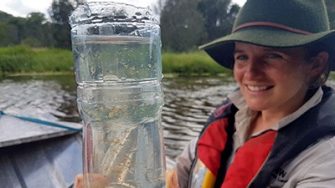
Tuckean Swamp is a 6,000 hectare low-lying floodplain located on the Richmond River, which has been extensively drained since the 1880’s. By 1971, the existing drainage works were completed with the installation of the Bagotville Barrage, a large one-way flow control structures that excludes tidal exchange and prevents backwater flooding from the estuary. These drainage works altered the hydrology of the Tuckean Swamp floodplain, lowering the water table and exposing highly acidic soils to oxygen.
The ongoing drainage of the floodplain sees the regular discharge of highly acidic waters (pH < 3) with extremely high concentrations of iron and aluminium. Due to the very low-lying elevation of Tuckean Swamp, prolonged inundation following wet weather results in the generation of low dissolved oxygen ‘blackwater’ runoff. As a result, the impacts to the Richmond River estuary and wetland ecology itself has been significant.
Engineers at the Water Research Laboratory worked with landholders and stakeholder groups to prioritise acid generation across Tuckean Swamp, and develop a range of drainage management restoration options that aim to improve water quality and reduce the impact of runoff from Tuckean Swamp. The field observations showed extensive deposits of Monosulfidic Black Ooze (MBO) within the waterways, surface water acidity with a pH = 2, and the discharge of expansive iron floc plumes into the Richmond River. The field measurements were used to inform the development of a conceptual understanding of the floodplain and to construct a detailed numerical model. Model simulations of various remediation options have allowed the risks and benefits of different strategies to be quantified and integrated into the functional designs of on-ground works.
The involvement of key project stakeholders was critical to the overall success of the project so far, with partners from both local and state agencies, including; National Parks and Wildlife Services, NSW Department of Planning, Industry and Environment, Local Land Services, Jali LALC, NSW Department of Primary Industries – Fisheries, Rous County Council, Ballina Shire Council, Lismore Shire Council, The Nature Conservancy, and OzFish Unlimited. Funding was provided by the Saltwater Recreational Fishing Trust Flagship Fish Habitat Action Plan.
For further information please contact:
Alice Harrison | Principal Engineer | a.harrison@wrl.unsw.edu.au

